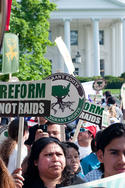I know the media confusion story of the past week is all about the momentary misreporting that got the story of the Supreme Court ruling backwards. Yet there was some real misoverestimating across the nation over the latest census numbers that were released recently on municipal population estimates for 2011. read more »
Demographics
Pakistan: Where the Population Bomb is Exploding
In much the developed, as well as developing world, population growth is slowing. Not so in Pakistan according to reported preliminary results of the 2011 Pakistan census. Here population is growing much faster than had been projected. Pakistan's population stood at 197.4 million in 2011, an increase of 62.7 million from the last census in 1998 (Note 1). The new population is 20 million more than had been forecast in United Nations documents. read more »
U.S. Desperately Needs a Strategy to Attract the Right Skilled Immigrants
President Obama’s recent “do it myself” immigration reform plan, predictably dissed by conservatives and nativists, reveals just how clueless the nation’s leaders are about demographics. Monday’s Supreme Court ruling on Arizona’s immigration crackdown also broke down along predictable lines, with both parties claiming ideological victories.
Yet the heated debates are missing the reality of immigration and its role in America’s future. In reality America needs more immigrants, but with a somewhat different mix. read more »
- Login to post comments
Thunder On The Great Plains: A Written-Off Region Enjoys Revival
They may not win their first championship against Miami’s evil empire, but the Oklahoma City Thunder have helped to put a spotlight on what may well be the most surprising success story of 21st century America: the revival of the Great Plains. Once widely dismissed as the ultimate in flyover country, the Plains states have outperformed the national average for the past decade by virtually every key measure of vitality — from population, income and GDP growth to unemployment — and show no sign of slowing down. read more »
The Evolving Urban Form: Tokyo
Tokyo is the ultimate in urbanization, being nearly one-half larger than any other urban area in the world. Further, Tokyo has retained its position as the largest urban area in the world for longer than any period since London's approximately 100 year run from the early 1800s to the early 1900s. During the 1920s, New York became the largest, but was displaced by Tokyo in 1955. read more »
Millennials’ Home Ownership Dreams Delayed, Not Abandoned
Eighty percent of Americans buy their first house between the ages of 18-34. While the Millennial Generation’s (born 1982-2003) delayed entry into all aspects of young adulthood has sometimes been characterized as a “failure to launch,” the generation’s preference for single tract, suburban housing should become the fuel to ignite the nation’s next housing boom as Millennials fully occupy this crucial age bracket over the next few years. read more »
Cities, Cars, People: Is Changing Car Use a Function of New Urbanism?
One cornerstone for urban designers and planners seeking to transform the polycentric or suburban city of the 20th Century into something resembling the high density city of the 19th was a cross-city comparison by Newman and Kenworthy and successors. read more »
Enterprising States 2012: Beating the New Normal and Policies that Produce
The following is an exerpt form a new report, Enterprising States, released this week by the U.S. Chamber of Commerce and National Chamber Foundation and written by Praxis Strategy Group and Joel Kotkin. Visit this site to download the full pdf version of the report, or check the interactive map to see how your state ranks in economic performance and in the five policy areas studied in the report. read more »
The Evolving Urban Form: Cairo
Cairo, Egypt's capital, has long had some of the highest neighborhood population densities in the world. In the 1960s it was reported that one neighborhood had a density of 353,000 people per square mile (136,000 per square kilometer). read more »
- Login to post comments
America's Two Economies
Surely you’ve seen it in your own neck of the woods: great contrasts between prosperity and wealth on the one hand, and hardship and despair on the other. I have certainly seen it in every place I have been over the last four years. read more »






















